Using flash in Near Darkness, Loy Krathong

|
• Flora Hotel Apartments • Flora Park Hotel Apartments • Fortune Hotel Dubai • Grand Moov Hotel |
Feature Photograph

Happy belated Loy Krathong! Loy Krathong is my favorite Thai holiday and I think many share my sentiments. Yours truly was out on the On-nut klong in a motorized sampan with camera in hand doing his best to refine techniques for shooting in very near darkness and to see if I could do better than last year. This particular image is significant for two reasons. First, it’s my favorite shot from the evening. Second, it has very poor image quality. How can it be my favorite image with such poor image quality? I suppose that’s a conundrum when torn between the technical and artistic. I wanted to share this image to encourage those who think because the image quality is poor the image’s artistic worth is somehow lessened. Perhaps it is, but it should still be shared. Let me tell you about this image.
We were motoring slowly under a huge concrete overpass with the expressway thundering overhead. Dark doesn’t begin to describe it. One of my guests was doing double duty as a light stand and aiming my wireless strobe wherever I aimed my big white zoom lens. It was a thing of beauty as we were able to sync without words or gestures, being a photographer himself he instinctively knew where the picture would be and the light was always aimed in the right direction. We both heard some splashing and saw a small boy swimming in the dirty klong water collecting krathongs and looking for the small coins within. We shot a few of him (see next picture below) and then off to the side, way out of range of the light, I saw movement and fired off a shot guessing at all the variables. Imagine my surprise when later at home I find a second small boy bobbing in the water near a colorful sampan watching us from the darkness!
Lucky shot? Certainly. I’ll take it though. I used every bit of the power of raw images, Lightroom, and Photoshop to draw out the colors and exposure of this image. You can see the heavy noise on the boys face which required the most adjustment and the noise (especially in the diagonal green stripe) on the boat. Still, it’s colorful, well composed, and I think interesting.
The second boy was within range of the setting I had manually set into my camera and flash and even though image quality wise it is far superior, I think it’s a much less interesting image.

Weekly Photo Outing
The best laid plans.. For months now I’d been looking forward to covering the royal cremation ceremonies including the performing orchestras and choirs. I’d managed to secure passes, arrange for an assistant, and was really looking forward to this special event. Unfortunately two nights before I was out on the klong covering the Loy Krathong festivities and on the way back I stepped in a pothole and threw my back out. The night of the cremation ceremonies I was still in some serious pain and couldn’t walk very well at all and considering the distances and crowds decided to bow out gracefully. I was very disappointed. Somehow my disappointment was relayed to the choir I’ve covered several times before and the choir members pooled the images from their compact cameras, wrote some narrative, and emailed me these images and narrative. Thank you! It really means a lot to me they went to this trouble, and I hope the readers can enjoy this special contribution as much as I have. Thank you guys!
We had a great and rare opportunity to be part of a huge royal event, the royal cremation of the late Princess Galyani Vadhana, our King’s sister. She passed away in January from cancer and they were cremating her past Saturday. We were thrilled to be part of this historical event. We were singing on one of three stages that had music and dance performed all night long.
We were amazed at the sight of Rajadamnoen Avenue (meaning The King’s Walk ) when we were going into Sanam Luang where the cremation was to take place. The Avenue looked deserted. It was closed down along with fifteen other streets in around the venue.
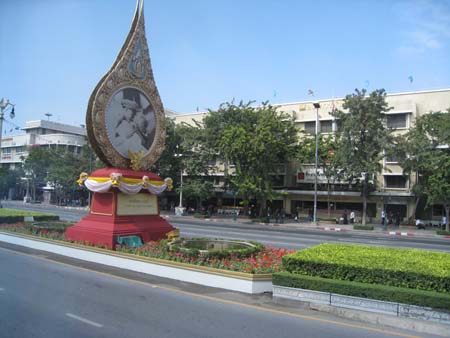
The Democracy Monument without demonstrations looked very beautiful.
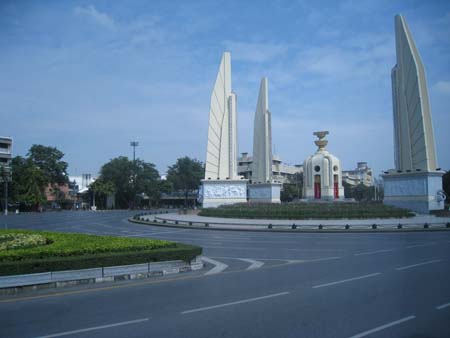
People were walking in in a very orderly fashion. They got dropped off by public transportation and walked for kilometers into the area.
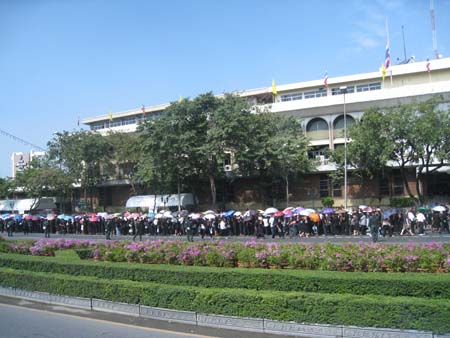
Hundreds of thousand people were there in the heat. The brief heavy rain at 2:30am the next day didn’t even bother them.
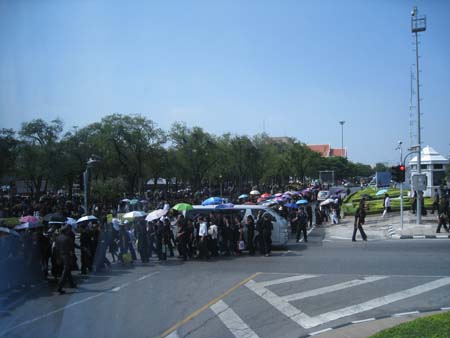
They put her upright golden casket on top of this car and transported her from the palace to Sanam Luang. It was a solemn funeral parade. We got there after the parade was over but got to see it on TV a little.
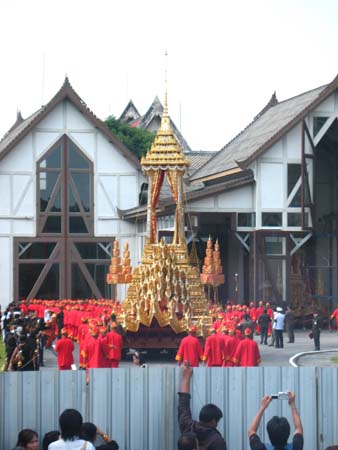
We got there at 1:30pm but scheduled to sing at 8:30pm so here was something we did to pass time..
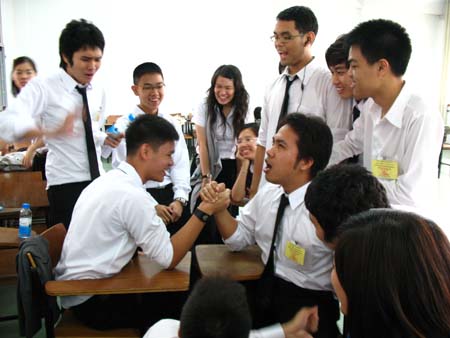
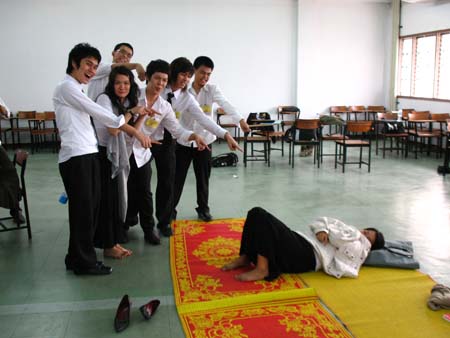
Finally got ready to go standby behind the makeshift stage.
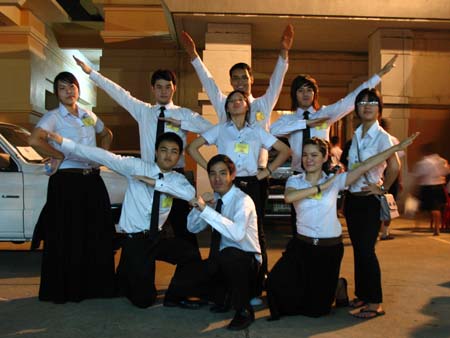
The ceremony was way behind the schedule and we ended up waiting for SIX hours behind the stage. We got on the stage at 2:30am and we were done singing at 3am. It was a fun time waiting in the back.
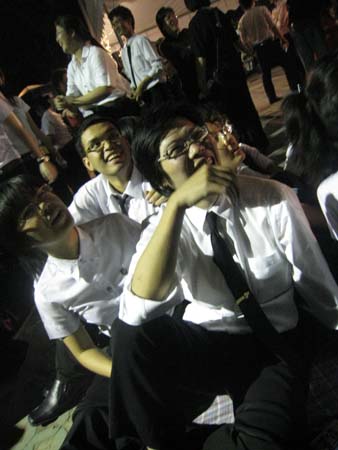
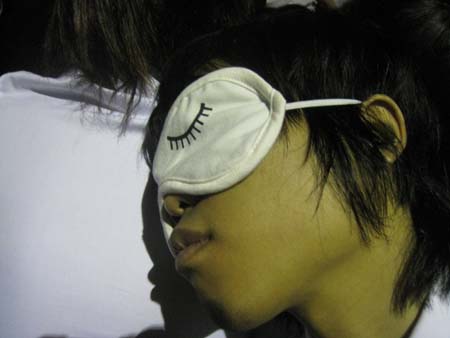
A fun shot of my conductor behind the stage.
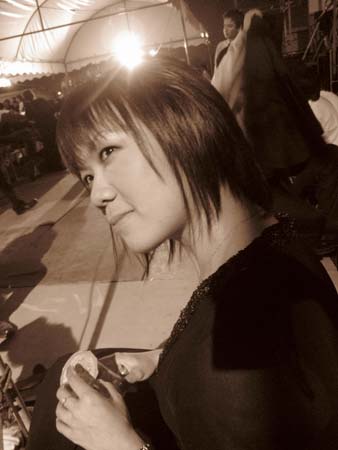
Me and my conductor
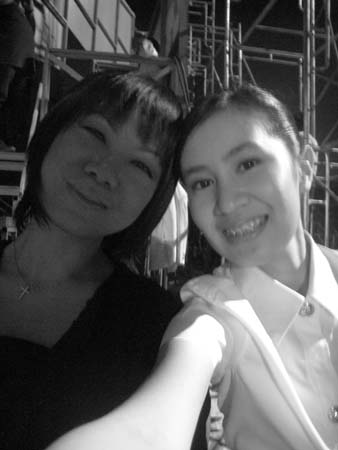
View of the ceremony from our stage taken by my tiny Canon Ixus camera
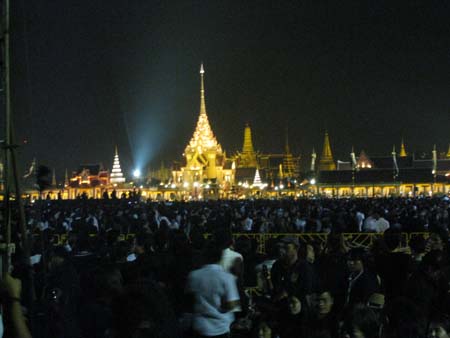
It was a great experience for us, Thai Youth Choir. We had a lot of fun working and performing, and being part of such an event is so memorable!
Using Flash in Near Darkness
Last year for Loy Krathong I cruised the same klong in the same area and dedicated myself to not using a flash. This means I was shooting at ISO 3200 which was the cameras limit and shooting wide open at either F2.8 with my 70-200/2.8 IS zoom, or F1.8 with my 20mm wide angle prime. The images were ok, but challenged. This year I was determined to do something different trying for the same effect but with a much higher image quality.
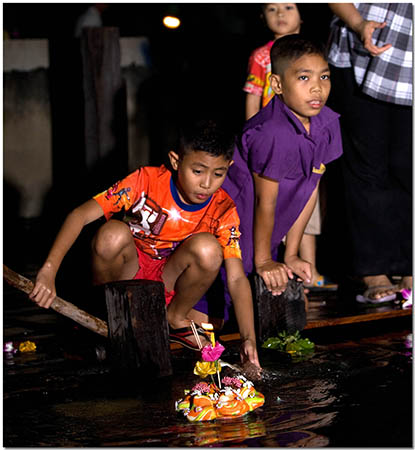
To achieve this I set the camera for manual mode and used a wireless portable strobe in manual mode. This effectively gave me a optimum working distance of 15-20 feet, and I could push the exposure in RAW out to about 30 feet with good results.
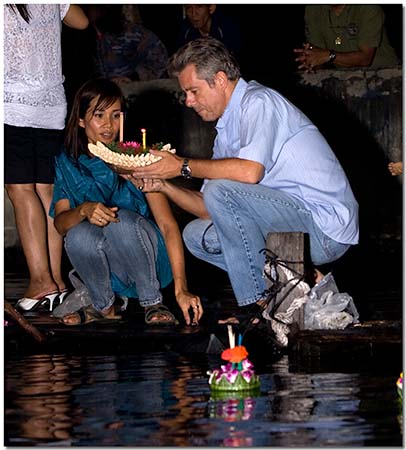
What, no automatic flash? I have never met an automatic flash I can count on and I’ve had many including Nikon SB800’s and Canon 580ex’s. I still own and sometimes use the 580ex’s. Used in carefully selected controlled environments they do indeed work in automatic mode. However, they are very limited in power output, recycle time, and light quality when compared to my Quantum 5d. You can look at it here.
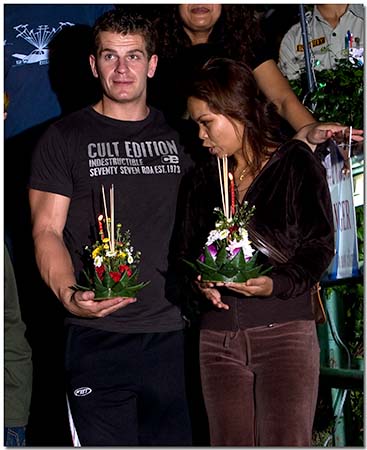
The Quantum Qflash’s are awesome professional units with an array of accessories and options and most first timers study their site for a long time before even knowing what to order to get started. The light quality is outstanding and I use these all the time for impromptu model shoots while on the road, weddings, and outdoor portraits. A great professional tool!
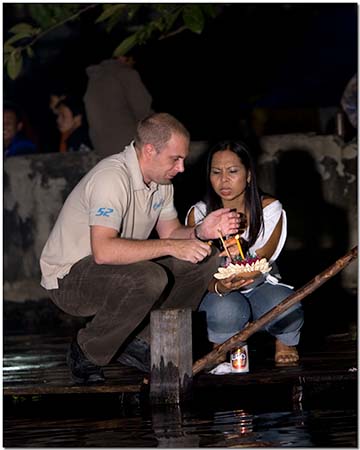
You can always tell when you have a great light quality when the skin tones of different races appear correct.
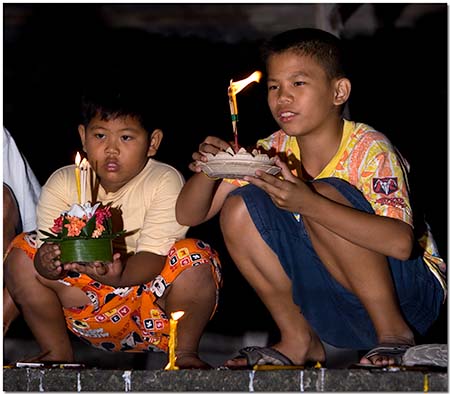
How dark was it out there? So dark that with the naked eye you could usually see only shapes, but not detail, no eyes, and there was no way for the camera to autofocus because it was just too dark for the autofocus sensors. Looking through the viewfinder all you could see was dark shapes and movement.
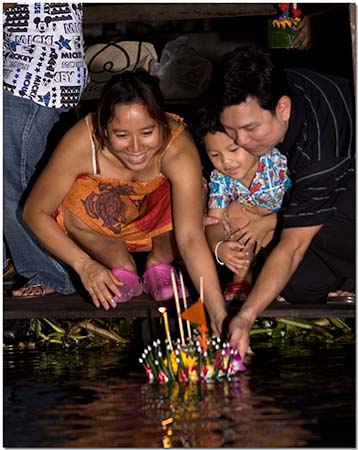
So how did we focus? I placed the sensor on the candle flames and let the camera lock focus automatically and then with my hand on the manual focus override gently pulled the focus in the desired direction while holding down the shutter release in a burst of 4-6 images. One or two of these images turned out to be in focus or very close to in focus and usable. This might sound haphazard but indeed it’s very close to the technique I use when covering live events on the streets. You might get 4-5 images which are unusable, but you can easily live with the 1-2 images which are. It’s just another way a DSLR becomes more usable in the field than an SLR film camera.
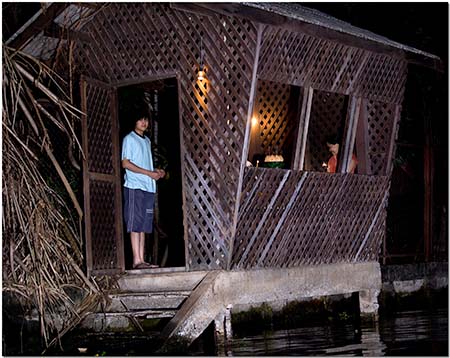
Each time we got to an interesting scene I’d ask the sampan pilot to move within range, slow down, turn the boat sideways if possible, and then I’d frame my shot, notice that my guest playing portable light stand was locked in as well, center the center AF sensor (the center AF sensor is the most sensitive of your AF sensors) on the candle flame and lock in AF, and then manually “pull” the focus either forward or backwards depending on where the main subjects were in relation to the flame.
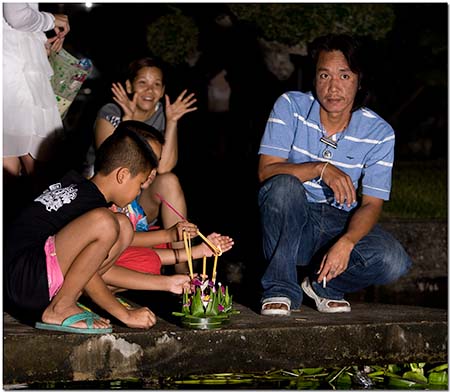
Using this technique I was able to shoot at ISO 200, 1/100th, and I’d manually vary the aperture between F2.8-5.6 depending on the estimate distance. The flash was set to half power to ensure a quick recycling time for the bursts of images I’d take.
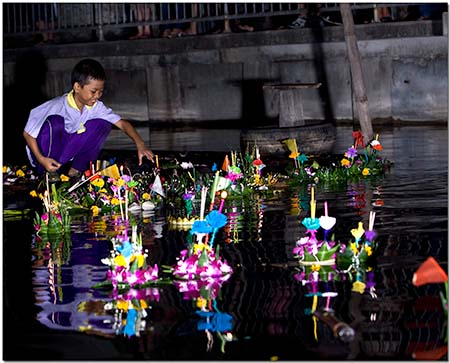
Once dialed in it was just a matter of looking for the right scenes and firing off a burst of 4-6 images.
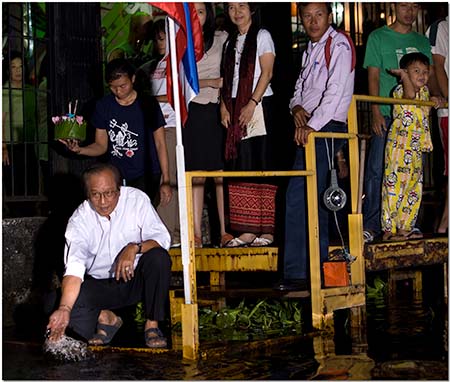
By limiting the power I limited the range of the flash, ensuring I was illuminating the subjects, but at the same time not the background. A high percentage of shots were my reward for this technique with an unusually high image quality for this type of shooting.
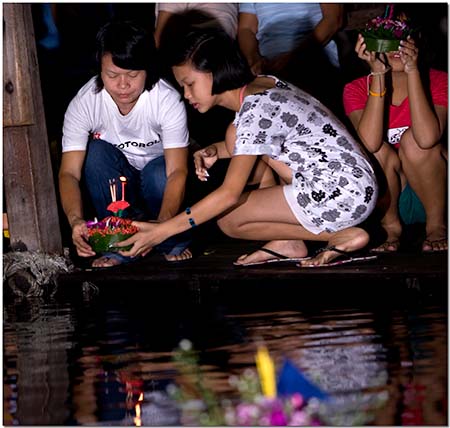
It only took a few minutes to dial in the settings and technique and from then on I sat back relaxed and looked for the shots I was after.
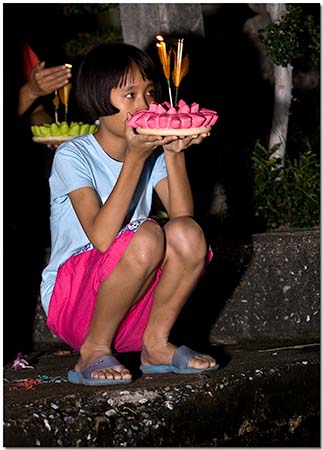
Photography News of Interest
I lived on Okinawa for over three years and enjoyed it more than any place I’ve ever lived. So imagine my interest in a new pictorial book by Shokyu Otsuka showing images from all over the island. I’ve just ordered mine! You can read the story at this link.
He with no emotions. Leonard Nimoy does erotic photography. Who knew! Read about it here.
Heck, this isn’t a trend. Prior to my last move to Bangkok my studio on Oregon did several boudoir sessions a week for brides, housewives, and girlfriends. It didn’t take long till this type of photography was my mainstay. Brides.com says it’s a new trend. Read about it here.
Underwater fashion photography? V magazine features an exciting fashion editorial using underwater fashion photography. I love the originality! Read about it here.
Readers' Submissions
Hello again Steve
I have looked through some of my pictures and have gathered an assortment of travel pics from over the years. Most were taken with the Canon Powershot 650 IS, others with an Olympus compact. No doubt you'll discern the difference. . . !

I'm enjoying using my new Sony (it's a "DSC H50", BTW) but miss the Canon. It had a larger body, though with 4 x AA batteries installed you'll rarely have to worry about losing power! I think I only had to recharge it 3-4 times in 18 months!!
Sea: It's what Oz is all about!

Waterfall: One for Stick: South Island NZ . . but where was it taken? <Cripes, I am a north island boy! You're putting me under pressure with this one! – Stick >

Loei Province: A never-ending sea of luscious emerald green

Tenterfield, NSW, Australia. Woke up one morning to this wonderful sight.
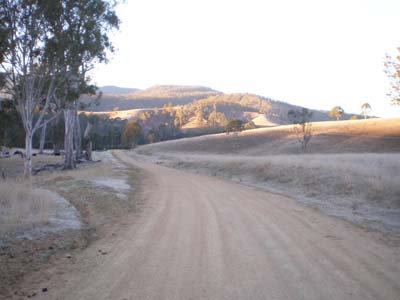
Bali: A lucky shot – stopped at a roadside festival and caught this trio with my telephoto.

Text to accompany the photos:
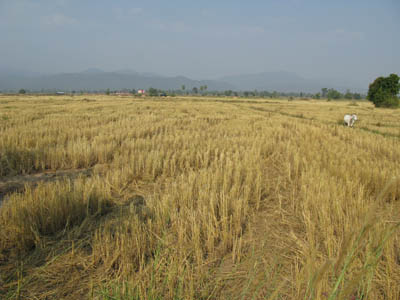
Steve, I am grateful to you for sharing your knowledge. I've attached a few memories over the last few years travelling, captured using a Canon Powershot A650 IS. Including is the north of Thailand, Australia and New Zealand. I hope you enjoy them.
There are 000's of miles of pristine beaches in Oz.
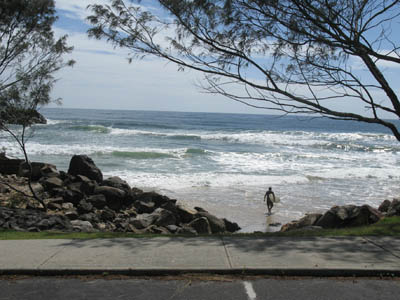
And here is the perfect way to see them!!
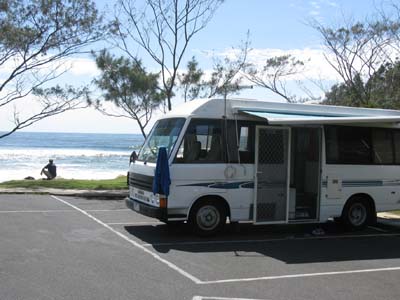
David – Thank you very much! I really enjoyed these pictures. The waterfall is wonderful. Lets see if Stick can guess the kiwi image.. ;o)
I suspect the readers submissions will be a highly anticipated section of this column and I encourage anyone with photographs and travel accounts they d like to share to please send them to me at: QandA@Bkkimages.com
Readers Questions
Yea Steve – I think of that old adage 'much learning hath made thee mad'! That's how I feel @ the moment. I have read so much I feel like I will explode if I read anymore.
I will wait for my two cameras to arrive and reassess it from there. My 6×7 system (Pentax 67ii) will come either tomorrow or Thursday. I made a boo boo on my eBay bid and did not know the system well enough. I thought it would come with the AE prism with spot, zone and average metering. However it is only the non-metering prism so now I am stuck with using a hand-held meter (which I don't have) or having to spend about another $600 on a used Pentaprism from the states (don't seem to be any around Aus).
My F5 is getting serviced and should be back in about a week. I love using film and I would stick with it if I could. However the rub for me is getting quality scans. I know I will be able to from my 6×7 system, but the 35mm I have doubts (as you said). However somebody did tell me that technology has increased markedly with scanners so the quality is now much closer to something straight from a DSLR????
Please don't think I am playing the antagonist and trying to refute everything you say. Be it far from that. You obviously know a zillion times more that me on this subject. I am just chucking questions and statements around to try and come to grasp with all this stuff in my head.
The thing that Rockwell says that I like is that (that is if the scans are as good as he says) you can concentrate on your shooting with a film camera. Come back at night and enjoy yourself without having to spend a long time mucking around on the computer. As I said computers drive me nuts – I hate using them. If I can nail the shot in the F5 and the Pentax 67, send it off to my lab to have proofs printed and then scanned onto a disk – then that sounds really really good to me! AS an alternative I have been pricing a Nikon coolscan 9000 – some say the scans from these are brilliant. What do you think? I could then scan my own – means only needing to pay for the E6!
Will be good to see those threads on Stick soon!
Keep me posted!
Phil
Philip –
Sorry for taking so long to get back to you on this one. Seriously busy.. a few workshops, on the boat for Loy Krathong last night, and prepping for the cremation coverage this Saturday.. need a beer.. ;o)
Yes.. some of the photo flatbed scanners from Epson are relatively inexpensive and remarkably good. I’ve scanned some 4×5’s on my three year old model and even with the included software they turned out great. I’m sure the new ones would be better considering technology moves pretty fast.
Rockwell.. concentrating on shooting.. Fair enough if you have his experience and make perfect exposures every time. Digital allows far greater latitude in every way not to mention instant feedback in the form of an image and/or histogram (I prefer and teach the histogram as a major tool). Digital is so good.. I wouldn’t shoot film without a DSLR there to double as my light meter. You’ll nail shots, but without the feedback you’ll nail far fewer than with a DSLR unless you’re an accomplished pro who works every day..
What I did.. was by a DSLR to fit the lenses I had for the F5.. slowly worked my way into it. Now, I’d much rather shoot digital than 35mm.. and my 1ds2 is so good it compared favorably to 4×5 film. I could do better with 4×5 film where it comes to resolution.. not sure about color tones.. but only marginally.
Steve
Hi Steve,
having been somewhat of an amateur photographer for many years — with some decent results I might add — I greatly appreciate your column on stickmanbangkok.com. Thanks for that! I also always liked you submissions, by the way.
Now the reason for my mail.
1. You have stated several times that compared to 35 mm film, "digital does better". Allow me to disagree. While I am with you that on the recording end at least top-of-the-line digital cameras nowadays produce a quality comparable to 35 mm slides, I have not yet found a way to look at the results in a way that pleases me.
2. Let me explain. Apart from a digital compact that I bought a few months ago (Panasonic Lumix LX 2 — great little camera despite heavy distortion of the lens and ridiculously lousy image quality when compared to 35 mm film — but I should not compare apples with oranges), I am shooting slides. I have a 2m x 2m pull-down screen in my livingroom where I project them. I usually watch them from a distance of about 2m, but stand up and get closer whenever I want to see a detail.
Now I am not aware of a similar way to watch digital photos. I have a 24'' monitor, but looking at photos of this tiny size and with a resolution of a mere 2MP in landscape, or less than 1MP in portrait, with the monitor's grid always clearly visible, all the details lost and diagonal lines becoming veritable staircases, just isn't much fun. While I greatly appreciate the convenience and possibilities digital photography brings, this lack of a decent means to view the results so far has kept me from abandoning my trusty old 35mm camera.
I would need an output device, preferably a projector, with a resolution of at least 4000 x 4000 pixels, so I could at least view 12 MP pictures in their original resolution. This would still be only a fraction of the resolution I get from film, but I think I could live with that. Unfortunately, I am not aware of any such device, even if we don't talk about price (my Rollei projector with its APO-Rolleigon lens was about 200 Euros and has worked fine for 25 years now…).
So, do you have any recommendations? How do YOU enjoy the results of your photo outings?
3. Now, while I am at it, a second question. I am using a Contax camera with seven Zeiss primes. For situations where I don't want to put this expensive equipment at risk (skiing, sailing etc.), I bought a used Pentax ME with three Pentax primes a couple of years ago. While the Contax equipment is arguably some of the best money can (or rather, could) buy, one should think that the Pentax would also perform admirably.
Unfortunately, this is not the case. If I mix slides taken with the two cameras, I can clearly distinguish the ones from the others. And I don't know why. The Pentax images are also crisp, there is no noticeable distortion or aberration or whatever, but they are just not *alive*. They are mere *images*, not *the real thing*. I don't know if you understand what I mean; maybe you really have to see the slides.
Anyway, this has led to my not using the Pentax anymore. Now my question: Are there similar phenomenons in the digital world? And how could I find out about them without having a decent means to look at the photos? Because, as slide films are becoming harder and harder to get, some day I will clearly be forced to move to digital. And what could be worse than spending thousands of Euros for top-quality equipment, and be bored to death by the results it produces?
I'd be very interested to get your thoughts on these two issues. Thanks, and best regards,
Tomp
Tom –
Thanks for the questions and if you don’t mind I’d like to run them in next weeks column in case anyone else has the same things on their mind. Let me take them in order. And thank you very much for the positive feedback!
-
1. For a variety of reasons I think the best DSLRs are ‘better’ than 35mm but I realize some disagree. This really could cover an entire topic so allow me to give you some brief reasons and if you have any questions I’ll expand the explanations.
- A. 35mm film has a great deal of latitude during the development process where it comes to exposure, while slide (transparency) film has no latitude at all. Pros shoot transparencies because they give the best results and they’re very good at getting the exposures right the first time. Still you’re limited, read on.
- B. DSLRs have more latitude of exposure than transparencies if you’re shooting raw images.
- C. With DSLRs you can change your ASA/ISO from image to image, you can even set some DSLRs to auto ISO and it will do it on the fly which is great for action/sports shooting. Film/slides require changing film, or like I used to do carrying 2-3 bodies loaded with different ASA’s.
- D. While labs have greatly improved, they still have control of your negatives/positives. They either do it right or not. Few amateurs process their own these days. Shooting RAW with digital allows you to always be in control.
- E. DSLRs produce much better images at higher ASA/ISO’s than does film/slides. The difference is considerable. Even at the lower ISO’s digital has a noticeable difference.
- F. With the new 14 bit DSLRs it is very hard to see any difference in the tonal ranges between film/slides and digital when shot under the best circumstances. Digital is easier to shoot under less than ideal circumstances for the best results
- G. Resolution wise.. the best full frame sensor DSLRs will provide more detail than film no matter how fine the resolution they’re scanned at. I’ve compared thousands of negatives/positives processed on the best scanners and this is my overall opinion.
- H. Digital is much faster in almost everyway except post processing. For instance my DSLR has (2) 16gb flash cards in it and I can capture over 1500 raw images on these cards. I can also back up one card to the other for roughly 750 images. That would be an entire backpack full of film canisters to carry around not to mention the time taken to keep loading the camera and keep track of which canisters are empty/full.
- I. All of the above (plus more) leads me to my opinion that the best DSLRs are better than film overall. There are circumstances where I still shoot 35mm for the image quality, but these are getting less and less as technology advances.
- 2. Everyone’s use of their images is a bit different. Displaying them seems to be your main concern so let me address this. I put away my slide projector and screens when I purchased my first large screen HDTV and ran a video cable from my computer to the HDTV. Most professional monitors used for image processing are 1600×1200 (21.5”), but of course there are bigger ones, however actual pixel size gets larger the larger the resolution gets requiring more viewing distance. A HDTV in 1080p/I will provide 1920×1080 pixels of resolution which is really very good. I have a 50 inch 1080p monitor ten feet from my workstation where I throw up images to look at across the room like I would a slide show. I find the quality of the image, especially considering a HDTV is backlit, to be every bit as good as a slide presentation in a darkened room. Keep in mind that even if you have scanned the images at 4000dpi, you won’t necessarily get any more detail than a DSLR, chances are you’ll get less detail, so producing them at full resolution holds little if any advantage. Also, you can zoom/in out to inspect any part of the image on a HDTV just like you would a image monitor. You’ll need to compare these side by side like I have, but make sure the HDTV is being driven by a proper HDTV capable video card, the HDTV is color profiled, and you’re using a viewing program that allows full resolution. I think you’ll find the HDTV superior to view, and much superior in ease of use and capabilities like zooming and panning.
- 3. This is a good question and fortunately easy to answer. Most people are led to believe that ‘sharpness’ is a measure of a lens. Indeed, without sharpness a lenses usefulness is limited, but sharpness isn’t the only factor affecting your images. There is also contrast, color, and distortion. Contrast is the one that you’re probably lacking on the Pentax lenses which is producing a lesser lifelike image. The answer is your Contax lenses are most likely superior in quality than the Pentax lenses and produce perhaps equal sharpness, but superior contrast and color rendering. Probably less distortion as well. Quality optics really do make a difference and you’ll see the differences far beyond the sharpness factor.
I’ve very much enjoyed your questions. They show a very good insight into the use of your photographic tools. I know I’ve offered some opinions that you’ll need to ‘see to believe’, but I think if you take the effort to compare them side by side under the best circumstances you’ll come to agree with me. A quality HDTV for instance is important, but so is the right video card, cable connections, and color profiling. Each piece of the system needs to be correct to achieve the best results. And it really is about more than resolution when scanning and viewing your images. You can’t really compare the resolution of film/slides to a digital sensor because they are not direct equivalents. This would be like comparing a 15mp compact camera with a 2/3rd’s small sensor, to a 15mp full frame DSLR with a 36x24mm sensor where the pixels are 20x thee size of the compact.. not to mention the quality of the pixels.
Please feel free to ask any questions or for more explanations. This technology is highly dynamic and I continue to learn every day.
Take care
Steve
Hi Steve,
now that was quick… Just a short reply before I go to bed… And yes, please fell free to use these questions in your next column.
1. I fully agree with you with respect to all the advantages of digital you mention. If not, I would not be interested in this subject in the first place. By the way, I did not know that DSLRs produce better results at higher ISO than film. That's interesting. For quality reasons, I almost exclusively use 100 ISO film, with the very occasional 400 ISO in a second body. On a subjective scale, I'd say that the 400 ISO film delivers only 20% of the quality of the 100, so I avoid it whenever possible. (With my Lumix, ISOs of higher than 100 produce completely unusable results — but I knew this before I bought the camera so I can't blame anyone.)
2. By the way, even though I'm not a pro, I usually *do* get the exposure right. My Contax has 2% spot metering that I use a lot. (Is there a reason why almost all modern cameras don't provide real spot metering anymore? How can you get correct exposures without? I've tried matrix metering (not on my own camera, it doesn't have it) on several occasions, and it always produced at least 50% of incorrect exposures.)
3. I don't agree (yet) that even the best DSLRs get a better resolution than slide film. Some years ago, I did a non-scientific measurement of the resolution my equipment gives me, and came to about 35 MP as projected on screen. Which happened to coincide nicely with the resolution of about 100 lp/mm an average 100 ISO film should yield. But if you ad a scanner to the workflow, you are probably right. And even if you weren't right now, you would be a few years down the road… Not that it matters; the difference between 21 MP or 24 MP and 35 MP on the recording side is clearly *not* the reason that I am still using analog.
So, to sum up: We agree that top-of-the-line DSLRs nowadays offer an image quality comparable to slide film but are much more convenient to use and provide more possibilities, so you could call them superior indeed.
4. By the way, I once had some of my slides scanned in a lab. The results were so bad that this made me buy the Lumix for the increasing number of situations where I need pictures in electronic form. Don't ask me what they did wrong…
5. As for viewing, it seems to me that our satisfaction or dissatisfaction stems from different viewing habits… Just like in a movie theater where I tend to choose a seat not in the back but at a distance from the screen about equal to the image's diagonal, this is also my preferred viewing distance for my own pictures. When I move back from my 1920 * 1200 screen and the distance exceeds about 1.5 times the diagonal (i.e. about 3 ft. for a 24" screen), the limited resolution power of the eye kicks in, the grid disappears, and diagonal lines actually begin to look like lines… So when you look at your 50" monitor from a distance of 10 ft., I understand why you are satisfied with the resolution — in this case, the human eye is the limiting factor, not the device.
Thanks for your response to the Contax / Pentax question. That might indeed be the reason. Now what does this mean when evaluating digital cameras? (And I really mean cameras, not lenses.) Anything? Nothing?
6. Since you are apparently using Canon equipment: You do not happen to have any experience with using Zeiss Contax lenses on your bodies? Getting a 5D body and use it with my existing lenses could be a first step into digital SLR photography, but the results reported in various forums are of a very mixed nature. Apart from the obvious (no autofocus, only use of working aperture), some users also report incorrect metering, collisions with the Camera's mirror and other niceties, while others seem to be very satisfied with this setup.
Well — didn't I say "short" reply? Anyway, thanks for the useful discussions, and please keep up your good work!
Greetings,
Tom
Hi Tom –
Yes, quick..;o) I knew I was going to be out most of the next day so I wanted to get an answer off to you. Allow me to address your responses and maybe I can help you see where I’m coming from.
- 1. Yes, DSLRs do great (compared to any film) with higher ISO’s. Do keep in mind that the higher the ISO the less detail just like with film, but digital does do better. A feature of digital I forgot to mention properly is that film comes in different temperatures, daylight, etc. This makes it very difficult with film to get the correct colors, requires an array of correcting/color filters, and lots of experience. With a DSLR you have auto WB (temp) and if you shoot raw you can adjust after the fact, a huge advantage over film.
- 2. I used spot metering with film for ages. My Olympus SLRs had multi-spot capability and it worked out great. The better DSLRs will also have spot metering, but now through use of the histogram and raw matrix metering becomes preferable for overall speed.
- 3. This is the answer you might find hard to visualize. DPI or “resolution” with film becomes a function of the scanner. A 2000dpi scanner resolves so much, a 4000dpi more, and if they made a 20,000dpi even more. No matter how finely it scans, or dices and slices the piece of film, you’re only going to get so much detail out of that piece of film. You can certainly get 35mp’s worth of “lines”, but no where near 35mp worth of detail from 35mm film. You’ll need to shoot them side my side to become a believer.
- 4. Almost all of the newer labs have great computer controlled scanners providing up to 4000dpi scans as part of the processing, though most charge you extra for the service. You’ll find these scans very good.
- 5. Viewing devices. You’ll need to see this as well.. I’ve had many people familiar with slides look at my HDTV and find it preferable. Also, keep in mind that a DLP HDTV does not have a visible grid. All other types do.
- 6. I have used several Zeiss and Zuiko lenses on my Canons with the help of adapters. Overall, I don’t find them worth the effort. Besides, Contax and Zeiss designs while very good, are decades old technology. We do better these days and often include AF and IS..
I hope you’ve found some of this helpful. I don’t expect anyone to take on what I say 100%, but at least I hope it helps you look more closely in several areas.
Take care
Steve
Hi Steve,
don't worry — if I weren't interested in your opinion, I wouldn't have asked…
1. So you owned an OM 4? Great camera. I almost had bought it instead of my Contax back then… If I remember correctly, the reason that I didn't was because Olympus did neither make a 1.4/85 nor a 2.0/135mm lens — two "essentials" for me.
2. Regarding lens quality now and then: When I look at lens reviews or listen to what owners of modern cameras have to tell, it is hard to believe that today's lenses are of better quality, either optically or mechanically, than those of 20 years ago. (I am not talking about zoom lenses here; there clearly has been much improvement). But lacking any personal experience, I take your word for it. (The lens of my Lumix, despite its famous Leica brand name and its slow speed of 2.8 – 4.0, shows extreme barrel distortion and produces glare when shooting against the light, and is vastly inferior to my old SLR lenses. But of course that's comparing apples and oranges.)
3. There's one sentence in your response I disagree with: "You can certainly get 35mp’s worth of “lines”, but no where near 35mp worth of detail from 35mm film.". Because I have seen myself that it *is* possible. My set-up was like this: I placed my projector as far from the screen as possible. Must have been about 60, 70 ft.; I don't remember. And then I simply counted the detail on the screen, extrapolated it and came to roughly 5000 x 7000. This was for clearly distinguishable detail; if I had chosen "barely distinguishable detail", it would have been about twice that linearly, i.e. about 150 MP in total. Now that clearly wasn't an exact scientific experiment, but when the MP-discussion began, all I wanted to get was an idea of how many MP film can deliver… Not that it really matters, because even at my closer viewing distance, the eye limits useful resolution to about 12 MP.
4. Anyway, thanks for taking the time to answer my questions, and I'm looking forward to your next column.
Best wishes,
Tom
Hi Tom –
Great exchange! I have a lot of fun answering questions like these.
- 1. Yes, I’ve shot Olympus for decades and owned (still do) most of their DSLRs.
- 2. What I’m going to say is a thorny subject but it needs to be said. The main difference between feedback on lenses of the past and lenses today is the internet, forums, and on-line reviews. Everyone used to read their favorite magazines and take their word for it or not. Now, consumers can join hundreds of photography forums and share their experiences. I see the “this model produced a lot of bad copies” over and over again, and 99.9% of the time it’s just that the person doesn’t know how to use the lens, or has unrealistic expectations based on inexperience, but now has a forum to blab their uninformed opinions all over the place and people who will join them. In truth real photography pros don’t spend much time on photography forums and have enough experience to evaluate lenses without resorting to opinions of amateurs on forums. I’ve purchased over 60 Nikkor and Canon lenses over the last decade and never got a bad one or one that needed to be returned. Be careful what lenses you buy and you’ll find that 20-30 years of technology has indeed improved the lenses significantly.. just like technology has improved the performance of most other technical devices.
- 3. What you’re describing is the same as “zooming” in an image on your computer monitor. This isn’t producing more detail, it’s just allowing you to see it better. It’s also detail no one would ever see unless you made a billboard size print. I lived next door to a billboard artist once. He shot all his pictures with a compact digital that only had 4mp’s. The billboards looked great. You can also zoom a digital image, but there is no way by zooming in you can say it has the equivalent of “more megapixels”, it either has the detail or not before you zoom in. Like I said before, I’ve looked at thousands of comparisons and compared to the top DSLRs there really is no resolution “advantage” with 35mm film, and usually the disadvantages of film over digital as I explained earlier results in less detail because the exposure/temp/focus wasn’t as good. I think once you own your first DSLR you’ll become a believer.
- 4. Thank you for the questions. This has been a great discussion!
Take care
Steve
Please submit your questions to QandA@Bkkimages.com All questions will be answered and most will show up in the weekly column.
A Snapshot of Bangkok Images Week in Review
Another busy week as we covered the Loy Krathong festivities, hosted out of town guests, and planned to cover the royal cremation. Unfortunately I was unable to attend the royal cremation after throwing out my back.
I added a new gallery of about 50 images from Loy Krathong. You can view it here.
Infocus Blog
I have something weighing on my mind this week. First, let me tell you about my grandfather. He was a hillbilly moonshiner from the Arkansas hills who came to California in the 1930’s and worked his ass off building his business. By the time of his death it was the largest and most successful such business in the Los Angeles area. I remember going out with him on business deals and when his clients expected or wanted a written contract or agreement, he offered a handshake instead. This is the way my grandfather did business.
I remember as a boy him explaining it to me. He told me the handshake was more than an agreement to deliver services, it was also an implied understanding of the services to be performed and the duties of both parties to participate in the norm of the business practices to facilitate the deal to completion. There were specific duties expected on both ends of the handshake. Allow me to be more specific.
His business was a carpet factory and rug cleaning (a fleet of vans with truck mounted steam cleaners) as well as a 200 foot tower and special huge washers for the finest Persian rugs. Let’s say he made a deal with a condominium developer to carpet 220 units with a specific grade carpet at a certain price and time line. The handshake was made. Now, he carried over 400 colors/patterns in that grade and had access to thousands more through the mills he dealt with. Imagine, after the handshake, that the developer would say “well, bring over all 400 colors and patterns and keep installing them until we like one and then we’ll go with that.” Can you imagine someone doing that?
No, instead implied in the handshake was the duty of the developer to either know what colors/patterns he wanted, or to come into the factory and check out samples and determine what he needed. In some cases the client would give guidelines to the factories interior decorator and she would then make her selection of samples for the client to choose from. You see, the business practices for this industry were very specific and clear and implied in the handshake.
I was raised to believe a handshake was all that was necessary to do business with people you’d really want to do business with. That part is easy, but what about the people you seal a deal with a handshake with who don’t intend, either through ignorance or just plain arrogance, to change the standard practice and demand all 400 samples plus more from the mills, be brought over and laid in each unit until the developer liked one?
I think these people are few and far between, and you learn to write them off as business expenses. They disappoint you, but you learn about character and you’re more careful the next time you shake someone’s hand.
Should I use contracts? I’ve long thought about this. Surely most people feel more obligated these days to go along with the industry norms, do their duty as a client, and cooperate as much as possible so they don’t risk their deposit the contract demands. Yes, I don’t believe in deposits either. Just a handshake and the word of a good man.
Perhaps I’m too old to change. So far in three years in Bangkok, and four years running a studio in Oregon, I’ve only had one unhappy customer. I’m proud of that. It was worth a bad handshake. I admired my grandfather and to honor him I’ll continue with no deposits and no contracts, just a handshake in the tradition of times gone by. Wish me luck.



